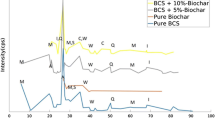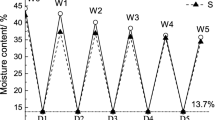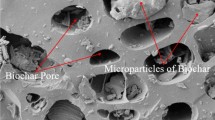Abstract
In recent years, biochar has been widely used in environmental and geotechnical engineering applications, but minimal studies have been done on its influence on soil engineering properties. In this study, the effect of biochar on the compression and swelling characteristics of two clayey soils, namely PKE and XS, was studied by conducting standard consolidation tests and no-load swelling tests. The compression curves and swelling parameters of modified clays with different biochar content (0, 0.5, 1, 2%, w/w) and biochar particle sizes (< 0.15, 1–2 mm) were obtained. The microstructure of the biochar-clay mixture was analyzed by scanning electron microscopy (SEM) test. The results showed that: (1) the compressibility of clayey soils can be effectively reduced by adding biochar, and this effect is more significant with the increase biochar percentage; (2) the effect of reducing soil compressibility by fine biochar was better than coarse biochar; (3) under the same pressure, the settlement rate of soil increased with the increase of biochar content; (4) the incorporation of biochar had no obvious influence on the no-load swelling behaviour of PKE while it has significantly increased the swelling of XS (low expansive soil). Additionally, the fine-grained biochar has a significant effect than the coarse-grained biochar on clayey soils.






Similar content being viewed by others
References
International Biochar Initiative (IBI) (2012) Standardized product definition and product testing guidelines for biochar that is used in soil. International Biochar Initiative, New York
Duku MH, Gu S, Hagan EB (2011) Biochar production potential in Ghana—a review. Renew Sustain Energy Rev 15:3539–3551. https://doi.org/10.1016/j.rser.2011.05.010
Wang J, Wang S (2019) Preparation, modification and environmental application of biochar: a review. J Clean Prod 227:1002–1022. https://doi.org/10.1016/j.jclepro.2019.04.282
Herrmann L, Lesueur D, Robin A, Robain H, Wiriyakitnateekul W, Bräu L (2019) Impact of biochar application dose on soil microbial communities associated with rubber trees in North East Thailand. Sci Total Environ 689:970–979. https://doi.org/10.1016/j.scitotenv.2019.06.441
Gong X et al (2019) Biochar facilitated the phytoremediation of cadmium contaminated sediments: metal behavior, plant toxicity, and microbial activity. Sci Total Environ 666:1126–1133. https://doi.org/10.1016/j.scitotenv.2019.02.215
Garg A et al (2020) Mechanism of biochar soil pore–gas–water interaction: gas properties of biochar-amended sandy soil at different degrees of compaction using KNN modeling. Acta Geophys 68:207–217. https://doi.org/10.1007/s11600-019-00387-y
O'Connor D et al (2018) Biochar application for the remediation of heavy metal polluted land: a review of in situ field trials. Sci Total Environ 619–620:815–826. https://doi.org/10.1016/j.scitotenv.2017.11.132
El-Naggar A et al (2019) Biochar application to low fertility soils: a review of current status, and future prospects. Geoderma 337:536–554. https://doi.org/10.1016/j.geoderma.2018.09.034
Banitalebi G, Mosaddeghi MR, Shariatmadari H (2019) Feasibility of agricultural residues and their biochars for plant growing media: physical and hydraulic properties. Waste Manag 87:577–589. https://doi.org/10.1016/j.wasman.2019.02.034
Hailegnaw NS, Mercl F, Pračke K, Száková J, Tlustoš P (2019) Mutual relationships of biochar and soil pH, CEC, and exchangeable base cations in a model laboratory experiment. J Soil Sediment 19:2405–2416. https://doi.org/10.1007/s11368-019-02264-z
Zhang L, Jing Y, Chen G, Wang X, Zhang R (2019) Improvement of physical and hydraulic properties of desert soil with amendment of different biochars. J Soil Sediment 19:2984–2996. https://doi.org/10.1007/s11368-019-02293-8
Pardo GS, Sarmah AK, Orense RO (2018) Mechanism of improvement of biochar on shear strength and liquefaction resistance of sand. Géotechnique 69:471–480. https://doi.org/10.1680/jgeot.17.P.040
Blanco-Canqui H (2017) Biochar and soil physical properties. Soil Sci Soc Am 81:687–711. https://doi.org/10.2136/sssaj2017.01.0017
Zong Y, Chen D, Lu S (2014) Impact of biochars on swell-shrinkage behavior, mechanical strength, and surface cracking of clayey soil. J Plant Nutr Soil Sc 177:920–926. https://doi.org/10.1002/jpln.201300596
Hossain MK, Strezov V, Yin Chan K, Nelson PF (2010) Agronomic properties of wastewater sludge biochar and bioavailability of metals in production of cherry tomato (Lycopersicon esculentum). Chemosphere 78:1167–1171. https://doi.org/10.1016/j.chemosphere.2010.01.009
Reddy KR, Yargicoglu EN, Yue D, Yaghoubi P (2014) Enhanced microbial methane oxidation in landfill cover soil amended with biochar. J Geotech Geoenviron. https://doi.org/10.1061/(ASCE)GT.1943-5606.0001148
Wong JTF, Chen X, Deng W, Chai Y, Ng CWW, Wong MH (2019) Effects of biochar on bacterial communities in a newly established landfill cover topsoil. J Environ Manag 236:667–673. https://doi.org/10.1016/j.jenvman.2019.02.010
Yargicoglu EN, Reddy KR (2018) Biochar-amended soil cover for microbial methane oxidation: effect of biochar amendment ratio and cover profile. J Geotech Geoenviron 144:4017123. https://doi.org/10.1061/(ASCE)GT.1943-5606.0001845
Zhang Y, Gu K, Li J, Tang C, Shen Z, Shi B (2020) Effect of biochar on desiccation cracking characteristics of clayey soils. Geoderma 364:114182. https://doi.org/10.1016/j.geoderma.2020.114182
Prakash A, Bordoloi S, Hazra B, Garg A, Sreedeep S, Zhu H (2020) Modeling dependence among suction, moisture, and cracking of a novel biochar synthesized from weed species. Adv Civ Eng Mater 9:20180092. https://doi.org/10.1520/ACEM20180092
Wei C, Gao W, Whalley WR, Li B (2018) Shrinkage characteristics of lime concretion black soil as affected by biochar amendment. Pedosphere 28:713–725. https://doi.org/10.1016/S1002-0160(18)60041-4
Bordoloi S, Gopal P, Boddu R, Wang Q, Cheng Y, Garg A (2019) Soil-biochar-water interactions: role of biochar from Eichhornia crassipes in influencing crack propagation and suction in unsaturated soils. J Clean Prod 210:847–859. https://doi.org/10.1016/j.jclepro.2018.11.051
SSPRC(State Standard of the People's Republic of China) (2019) Standard for soil test method (GB/T50123–2019). People's Republic of China Ministry of Construction, Beijing
Reddy KR, Yaghoubi P, Yukselen-Aksoy Y (2015) Effects of biochar amendment on geotechnical properties of landfill cover soil. Waste Manag Res 33:524–532. https://doi.org/10.1177/0734242X15580192
Rajkovich S, Enders A, Hanley K, Hyland C, Zimmerman AR, Lehmann J (2012) Corn growth and nitrogen nutrition after additions of biochars with varying properties to a temperate soil. Biol Fert Soils 48:271–284. https://doi.org/10.1007/s00374-011-0624-7
Zeng Z et al (2013) Sorption of ammonium and phosphate from aqueous solution by biochar derived from phytoremediation plants. J Zhejiang Univ Sci B 14:1152–1161. https://doi.org/10.1631/jzus.B1300102
Kinney TJ, Masiello CA, Dugan B, Hockaday WC, Dean MR, Zygourakis K, Barnes RT (2012) Hydrologic properties of biochars produced at different temperatures. Biomass Bioenerg 41:34–43. https://doi.org/10.1016/j.biombioe.2012.01.033
Sadasivam BY, Reddy KR (2014) Engineering properties of waste wood-derived biochars and biochar-amended soils. Int J Geotech Eng 9:521–535. https://doi.org/10.1179/1939787915Y.0000000004
Wong JTF, Chen Z, Chen X, Ng CWW, Wong MH (2017) Soil-water retention behavior of compacted biochar-amended clay: a novel landfill final cover material. J Soil Sediment 17:590–598. https://doi.org/10.1007/s11368-016-1401-x
Jačka L, Trakal L, Ouředníček P, Pohořelý M, Šípek V (2018) Biochar presence in soil significantly decreased saturated hydraulic conductivity due to swelling. Soil Tillage Res 184:181–185. https://doi.org/10.1016/j.still.2018.07.018
Gu K, Tang C, Shi B, Hong J, Jin F (2014) A study of the effect of temperature on the structural strength of a clayey soil using a micropenetrometer. B Eng Geol Environ 73:747–758. https://doi.org/10.1007/s10064-013-0543-y
Acknowledgements
This research was financially supported by the National Natural Science Foundation of China (41977217) and the Fundamental Research Funds for the Central Universities, China (020614380061).
Author information
Authors and Affiliations
Corresponding author
Additional information
Publisher's Note
Springer Nature remains neutral with regard to jurisdictional claims in published maps and institutional affiliations.
Rights and permissions
About this article
Cite this article
Zhang, Y., Gu, K., Tang, C. et al. Effects of Biochar on the Compression and Swelling Characteristics of Clayey Soils. Int. J. of Geosynth. and Ground Eng. 6, 22 (2020). https://doi.org/10.1007/s40891-020-00206-1
Received:
Accepted:
Published:
DOI: https://doi.org/10.1007/s40891-020-00206-1




